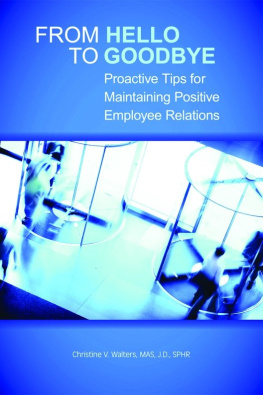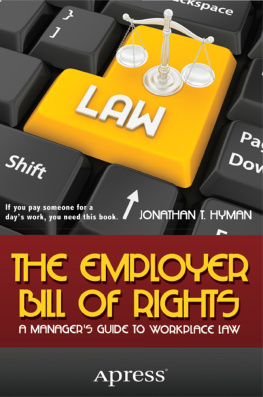

Copyright 2018 Charles H. Fleischer. All rights reserved.
This publication is designed to provide accurate and authoritative information regarding the subject matter covered. It is sold with the understanding that neither the publisher nor the author is engaged in rendering legal or other professional service. If legal advice or other expert assistance is required, the services of a competent, licensed professional should be sought. The federal and state laws discussed in this book are subject to frequent revision and interpretation by amendments or judicial revisions that may significantly affect employer or employee rights and obligations. Readers are encouraged to seek legal counsel regarding specific policies and practices in their organizations.
This book is published by the Society for Human Resource Management (SHRM). The interpretations, conclusions, and recommendations in this book are those of the author and do not necessarily represent those of the publisher.
This publication may not be reproduced, stored in a retrieval system, or transmitted in whole or in part, in any form or by any means, electronic, mechanical, photocopying, recording, or otherwise, without the prior written permission of the publisher, or authorization through payment of the appropriate per-copy fee to the Copyright Clearance Center, Inc., 222 Rosewood Drive, Danvers, MA 01923, 978-750-8600, fax 978-646-8600, or on the Web at www.copyright.com. Requests to the publisher for permission should be addressed to SHRM Book Permissions, 1800 Duke Street, Alexandria, VA 22314, or online at http://www.shrm.org/about-shrm/pages/copyright--permissions.aspx.
SHRM books and products are available on most online bookstores and through the SHRMStore at www.shrmstore.org.
The Society for Human Resource Management is the worlds largest HR professional society, representing 285,000 members in more than 165 countries. For nearly seven decades, the Society has been the leading provider of resources serving the needs of HR professionals and advancing the practice of human resource management. SHRM has more than 575 affiliated chapters within the United States and subsidiary offices in China, India, and United Arab Emirates. Please visit us at www.shrm.org.
Interior & Cover Design | Shirley Raybuck |
Manager, Creative Services | James McGinnis |
Manager, Book Publishing | Matthew Davis |
Vice President, Editorial | Tony Lee |
Library of Congress Cataloging-in-Publication Data has been applied for and is on file with the Library of Congress. ISBN (pbk): 978-1-586-44470-9; ISBN (PDF): 978-1-586-44471-6; ISBN (EPUB): 978-1-586-44472-3; ISBN (MOBI): 978-1-586-44473-0
Printed in the United States of America FIRST EDITION
PB P RINTING 10 9 8 7 6 5 4 3 2 1
61.11003 17-0820
Contents
While every attempt has been made to provide accurate, authoritative, and current information regarding the subject matter covered, this book is for general information only and is not intended as legal, tax, accounting, or other professional advice. The reader should consult an attorney, accountant, human resource professional, or other appropriate expert regarding specific questions or problems. Neither the author nor the publisher is liable for any errors or omissions.
Introduction
Not too many years ago, managing employer-employee relations was relatively simple. Little more was required than meeting payroll and remembering to deposit withholding taxes on time. Since then, life has become infinitely more complicated and uncertain. Employment practices that easily passed muster yesterday now expose employers to substantial risk and expense. At the same time, employees have become more knowledgeable about their rights and much less bashful about exercising them.
It is easy to cite examples of practices that may once have been common, but now, depending on the circumstances, could give rise to civil lawsuits and even criminal prosecutions. Do any of these sound like good ideas?
Ill just call my staff independent contractors and avoid the hassles that come with employees.
Bob worked overtime all day Saturday copying and stapling the proposal, so Ill give him a day off next week.
Nancy quit on me in the middle of her project. Theres no way Im going to pay her for the two weeks vacation she had coming.
If I hire through a temp agency, I can tell them to send me men for the sales positions and women for secretaries without having to worry about sex discrimination.
Becky in Accounting has been dating her assistant. I hear theyre having problems, but theyre just going to have to work things out.
The next person who gets his salary garnished is out of here!
If any of these strikes a familiar chord, this book is for you!
Employment is, fundamentally, an economic relationship. The employer seeks an employee who will work competently and dependably in furtherance of the employers business. The employee seeks regular work at reasonable compensation.
At the same time, the employment relationship is awash in powerful, psychodynamic currents. Employers, having risked their personal capital to keep their businesses afloat, may have unreasonable expectations of loyalty and devotion from their workforce. Employees, on the other hand, may feel at sea when subjected to seemingly arbitrary and unexplained decisions by their bosses. Both sides often define themselves and derive their sense of self-worth from the employment relationship, so stormy encounters can be treacherous.
Employment is also a highly regulated relationship. Since employers have historically held greater economic power than individual employees, federal, state, and even local governments have felt it necessary to intervene. As a result, employers do not have freedom to dictate (or even negotiate) many terms and conditions of employment. They must pay minimum wages and time-and-a-half for overtime. They must comply with detailed workplace safety standards. They must conform their employee benefit plans to complicated legal requirements. And they are forbidden from making employment decisions based on a host of prohibited criteria.
Employers are also easy targets for the imposition of requirements that otherwise have little to do with the employment relationship. In the income tax area, for example, employers enforce their employees obligations to the Internal Revenue Service (IRS) and to state taxing authorities by withholding an array of items from employee paychecks. Employers also finance government social policy embodied in workers compensation and unemployment compensation laws. They must even assist the government in collecting certain debts and locating parents who ignore their child support obligations.
This book is intended as an overview of U.S. workplace laws, regulations, and court decisions that employers, large or small, are likely to face. Some chapters explore the employment relationship primarily as it is affected by the common lawthe law we inherited from England and are developing by judicial decisions in this country. Other chapters deal with federal and state statutes that bear directly on the employment relationship or that impose obligations on employers. The goal in each case is to present general principles, to highlight hot issues, and to offer specific examples and suggestions to make the employer-employee relationship run more smoothly.
Next page









